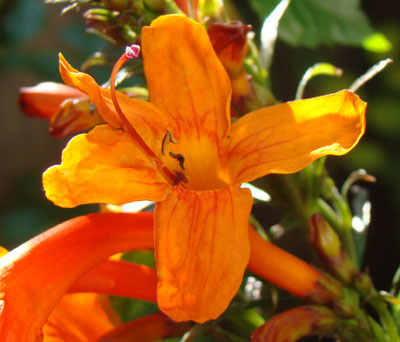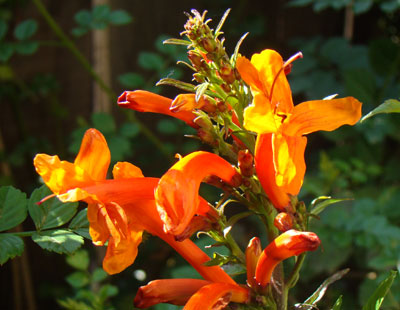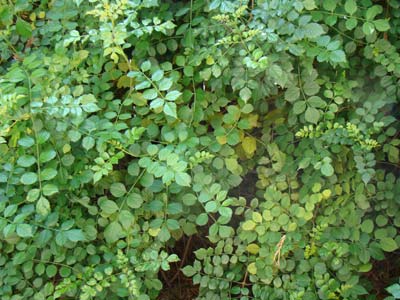Winters in the Central Valley of California are often white ... with fog, which settles in and obliterates any sense of east or west or noon or sunrise. When the fog settles in, day after day goes by with little to distinguish one from another. The temperatures drop gradually, until you feel as though the very blood is congealing in your veins, and as though all your joints are seizing up like the Tin Man going rusty in the movie The Wizard of Oz.

However, if you've planted your garden with an eye toward the seasons, then you may find a bright spot glowing even on the cloudiest of days. Tecomaria capensis, known frequently as "Cape Honeysuckle" is widely planted in milder climates as winter color. (Milder climates means "doesn't drop below freezing and stay there for 24 hours".) Its bright orange, tubular blossoms grace the delicately serrated, evergreen foliage from October through the winter, attracting wintering hummingbirds and adding color to the landscaping.

A native of South Africa, the tecomaria requires little water once established. Hard regular pruning can give you a lovely thick hedge or large shrub. I admired the plant greatly when I worked in the nursery department of a large hardware, turning again and again to its brilliant color in the wet cold months like a moth to a flame. The head of my department extolled the virtues of the plant: evergreen, rich foliage, attracts birds, survives many abuses, including extreme heat and drought.
When a customer returned a half-dead tecomaria, bare-rooted, in an old bucket, I took it home and planted it, pleased with the turn of fortune that brought such a lovely living thing to my door, hoping that I could nurse it back to health.

See the richness of the foliage?
This rich growth is a result of me cutting the thing back to the GROUND last spring and chopping off every bit of green.
The plant books, not even Taylor's Encyclopedia of Gardening tell the whole story about this plant. Truly I should have read between the lines. When I read that tecomaria is native to South Africa, I should have seen, "This plant grows like it has all of Africa to spread." And when I read that it was drought-resistant, I should have seen, "Under no circumstances give this bugger a regular water supply." And when I read the quaint description "scrambling shrub," I should have known that the blasted thing was going to crawl all over and through every other plant in my garden.
Now let me tell you why I really hate this plant.
Once it is established, you need a garden service with many chemicals and gas-powered garden equipment to keep it in check. Otherwise it will grow 30 feet up into a shade tree, or endlessly along a fence, seeking water. It sends out thick runners in every direction like a spammer sends cialis ads, and in a matter of hours, those runners put down roots every couple feet. After those little roots start taking in nourishment, the plant shoots up again into the air, seeking sun and more excuses to multiply itself.
The growth habit of tecomaria capensis is not straightforward, not in any direction. It grows in every direction constantly, so that the only way to trim it is to shear off everything that threatens to knock in your living room windows. You cannot trim it to be an open, airy shrub. It's branching arms loop through one another, wrap around one another, fuse with one another. We've spent hours trying to uproot the outgrowth that repeatedly tries to burrow under the foundations of the house. A stack of chopped inch-thick branches lies beside the porch, to be used as kindling, but still the plant continues to grow. I am very sorry it happened, but it has gone under the fence and invaded the neighbor's yard.
My recommendation is this: if a nursery person suggests Cape Honeysuckle (that's how they try to trick you into buying tecomaria capensis!) as a landscape plant for your yard, slap him or her so hard that they never say that again, and tell them that one's on me. And if you long for color in winter, take up oil painting.

The Piker Press moderates all comments.
Click here for the commenting policy.